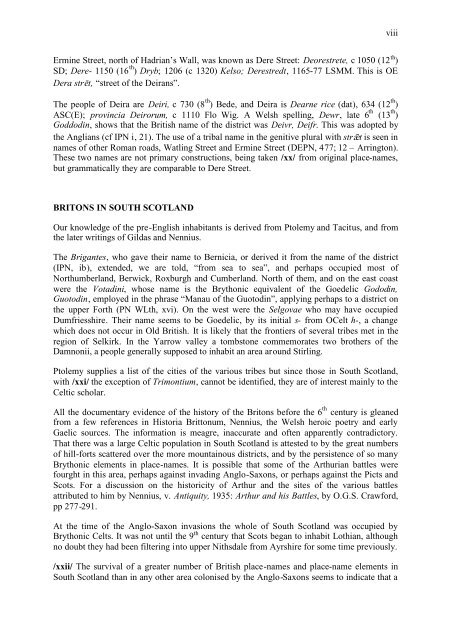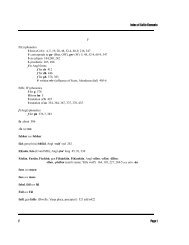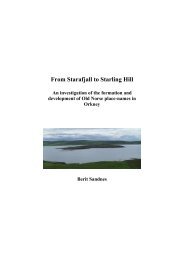May Williamson: The Non-Celtic Place-Names of the Scottish Border ...
May Williamson: The Non-Celtic Place-Names of the Scottish Border ...
May Williamson: The Non-Celtic Place-Names of the Scottish Border ...
You also want an ePaper? Increase the reach of your titles
YUMPU automatically turns print PDFs into web optimized ePapers that Google loves.
viii<br />
Ermine Street, north <strong>of</strong> Hadrian’s Wall, was known as Dere Street: Deorestrete, c 1050 (12 th )<br />
SD; Dere- 1150 (16 th ) Dryb; 1206 (c 1320) Kelso; Derestredt, 1165-77 LSMM. This is OE<br />
Dera strt, “street <strong>of</strong> <strong>the</strong> Deirans”.<br />
<strong>The</strong> people <strong>of</strong> Deira are Deiri, c 730 (8 th ) Bede, and Deira is Dearne rice (dat), 634 (12 th )<br />
ASC(E); provincia Deirorum, c 1110 Flo Wig. A Welsh spelling, Dewr, late 6 th (13 th )<br />
Goddodin, shows that <strong>the</strong> British name <strong>of</strong> <strong>the</strong> district was Deivr, Deifr. This was adopted by<br />
<strong>the</strong> Anglians (cf IPN i, 21). <strong>The</strong> use <strong>of</strong> a tribal name in <strong>the</strong> genitive plural with strt is seen in<br />
names <strong>of</strong> o<strong>the</strong>r Roman roads, Watling Street and Ermine Street (DEPN, 477; 12 – Arrington).<br />
<strong>The</strong>se two names are not primary constructions, being taken /xx/ from original place-names,<br />
but grammatically <strong>the</strong>y are comparable to Dere Street.<br />
BRITONS IN SOUTH SCOTLAND<br />
Our knowledge <strong>of</strong> <strong>the</strong> pre-English inhabitants is derived from Ptolemy and Tacitus, and from<br />
<strong>the</strong> later writings <strong>of</strong> Gildas and Nennius.<br />
<strong>The</strong> Brigantes, who gave <strong>the</strong>ir name to Bernicia, or derived it from <strong>the</strong> name <strong>of</strong> <strong>the</strong> district<br />
(IPN, ib), extended, we are told, “from sea to sea”, and perhaps occupied most <strong>of</strong><br />
Northumberland, Berwick, Roxburgh and Cumberland. North <strong>of</strong> <strong>the</strong>m, and on <strong>the</strong> east coast<br />
were <strong>the</strong> Votadini, whose name is <strong>the</strong> Brythonic equivalent <strong>of</strong> <strong>the</strong> Goedelic Gododin,<br />
Guotodin, employed in <strong>the</strong> phrase “Manau <strong>of</strong> <strong>the</strong> Guotodin”, applying perhaps to a district on<br />
<strong>the</strong> upper Forth (PN WLth, xvi). On <strong>the</strong> west were <strong>the</strong> Selgovae who may have occupied<br />
Dumfriesshire. <strong>The</strong>ir name seems to be Goedelic, by its initial s- from OCelt h-, a change<br />
which does not occur in Old British. It is likely that <strong>the</strong> frontiers <strong>of</strong> several tribes met in <strong>the</strong><br />
region <strong>of</strong> Selkirk. In <strong>the</strong> Yarrow valley a tombstone commemorates two bro<strong>the</strong>rs <strong>of</strong> <strong>the</strong><br />
Damnonii, a people generally supposed to inhabit an area around Stirling.<br />
Ptolemy supplies a list <strong>of</strong> <strong>the</strong> cities <strong>of</strong> <strong>the</strong> various tribes but since those in South Scotland,<br />
with /xxi/ <strong>the</strong> exception <strong>of</strong> Trimontium, cannot be identified, <strong>the</strong>y are <strong>of</strong> interest mainly to <strong>the</strong><br />
<strong>Celtic</strong> scholar.<br />
All <strong>the</strong> documentary evidence <strong>of</strong> <strong>the</strong> history <strong>of</strong> <strong>the</strong> Britons before <strong>the</strong> 6 th century is gleaned<br />
from a few references in Historia Brittonum, Nennius, <strong>the</strong> Welsh heroic poetry and early<br />
Gaelic sources. <strong>The</strong> information is meagre, inaccurate and <strong>of</strong>ten apparently contradictory.<br />
That <strong>the</strong>re was a large <strong>Celtic</strong> population in South Scotland is attested to by <strong>the</strong> great numbers<br />
<strong>of</strong> hill-forts scattered over <strong>the</strong> more mountainous districts, and by <strong>the</strong> persistence <strong>of</strong> so many<br />
Brythonic elements in place-names. It is possible that some <strong>of</strong> <strong>the</strong> Arthurian battles were<br />
fourght in this area, perhaps against invading Anglo-Saxons, or perhaps against <strong>the</strong> Picts and<br />
Scots. For a discussion on <strong>the</strong> historicity <strong>of</strong> Arthur and <strong>the</strong> sites <strong>of</strong> <strong>the</strong> various battles<br />
attributed to him by Nennius, v. Antiquity, 1935: Arthur and his Battles, by O.G.S. Crawford,<br />
pp 277-291.<br />
At <strong>the</strong> time <strong>of</strong> <strong>the</strong> Anglo-Saxon invasions <strong>the</strong> whole <strong>of</strong> South Scotland was occupied by<br />
Brythonic Celts. It was not until <strong>the</strong> 9 th century that Scots began to inhabit Lothian, although<br />
no doubt <strong>the</strong>y had been filtering into upper Nithsdale from Ayrshire for some time previously.<br />
/xxii/ <strong>The</strong> survival <strong>of</strong> a greater number <strong>of</strong> British place-names and place-name elements in<br />
South Scotland than in any o<strong>the</strong>r area colonised by <strong>the</strong> Anglo-Saxons seems to indicate that a




